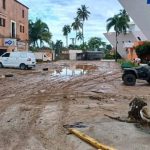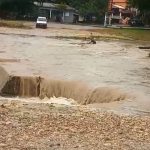Greenpeace investigation exposes failure of Fukushima decontamination program

Tokyo.– Radioactive contamination in the forests and landof Iitate district in Fukushima prefecture is so widespread and at such a highlevel that it will be impossible for people to safely return to their homes, aGreenpeace Japan investigation revealed today. The findings follow the AbeGovernment’s announcement on 12th June 2015 to lift evacuation orders by March2017 and terminate compensation by 2018, which effectively forces victims backinto heavily contaminated areas.
“Prime Minister Abe would like the people of Japan tobelieve that they are decontaminating vast areas of Fukushima to levels safeenough for people to live in. The reality is that this is a policy doomed tofailure. The forests of Iitate are a vast stock of radioactivity that willremain both a direct hazard and source of potential recontamination forhundreds of years. It’s impossible to decontaminate,” said Jan Vande Putte,radiation specialist with Greenpeace Belgium.
“The Japanese government has condemned the people ofIitate to live in an environment that poses an unacceptable risk to theirhealth. Stripping nuclear victims of their already inadequate compensation,which may force them to have to return to unsafe, highly radioactive areas forfinancial reasons, amounts to economic coercion. Let’s be clear: this is apolitical decision by the Abe Government, not one based on science, data, orpublic health,” he said.
Greenpeace conducted a radiation survey and samplingprogram in Iitate, including in its forests. One principle finding from theinvestigation is that the vast majority of Iitate will never be decontaminated,with most radioactivity deposited in the vast forested hills and mountains inthe district. The enormous scale of the forests was revealed by UAV footagefrom the investigation.
Even in the limited areas that have been decontaminatedaround people’s homes and land, and along roads, levels of radiation are stillat unacceptable levels. The results show that current decontamination programsare failing to significantly reduce radiation levels, which remain high andunsafe for people to live.
Even after decontamination, radiation dose rates weremeasured higher than 2uSv/h on decontaminated fields, the equivalent of anannual dose higher than 10mSv/year or ten times the maximum allowed dose to thegeneral public. In the untouched and heavily contaminated forests, radiationdose rates are typically in the range of 1-3uSv/h—high levels that will remainfor many years to come.
The only forest decontamination underway in Iitate isalong public roads, where thousands of workers are removing contaminated soiland plants along a 10-20 meter strip. The Japanese government plans to lift restrictionsin all of Area 2, including Iitate, where people could receive radiation dosesof up to 20mSV each year and in subsequent years.
International radiation protection standards recommendpublic exposure should be 1mSv/year or less in non-post accident situations.The radiation limit that excluded people from living in the 30km zone aroundthe Chernobyl nuclear plant exclusion zone was set at 5mSV/year, five yearsafter the nuclear accident. Over 100.000 people were evacuated from within thezone and will never return.
Supporting the Japanese government in its policy offorced return to a radioactive environment is the International Atomic EnergyAgency (IAEA), which has promoted the early return of Fukushima citizens toevacuated areas. Not only is the IAEA’s radiation risk assessments based onflawed science, where they are deliberately understating the risks fromradioactivity, they also have misrepresented the scale and effectiveness of thelimited decontamination program including in Iitate.
“Even after nearly thirty years, the 30km area around Chernobylremains an exclusion zone. It’s a shocking indictment of both the IAEA and theAbe government, which reveals how desperate they are to create the illusionthat returning to ‘normal’ is possible after a severe nuclear accident. Theirposition is indefensible and plans for a de facto forced return must bestopped,” said Mamoru Sekiguchi, energy campaigner at Greenpeace Japan.
The district of Iitate, which covers more than 200 squarekilometers, located between 28-47km northwest of the Fukushima Daiichi nuclearpower plant, was one of the most contaminated areas following the March 2011catastrophe. Since 2014, tens of thousands of workers have been attempting toreduce radiation levels in some parts of Fukushima prefecture, including inIitate, with little impact.
In early June 3.400 citizens of Iitate (more than halfthe population) called on the mayor of their community to reject thegovernment’s plans. At the same time, they are currently within the AlternativeDispute Resolution (ADR) process, where they hope to secure reasonablecompensation for the losses they have suffered.
“The gap between the amount of high and low compensationpayments is widening drastically, and the Iitate village people will have tokeep living a sad life in bitterness, separated from each other and away fromtheir home. The Iitate people’s fate is another of numerous cases in the pastwhere Japan abandoned its people, as with the Ashio mining pollution andMinamata disease. We can not allow this to happen again,” said Yasushi Tadano,the lawyer defending the people of Iitate.

















